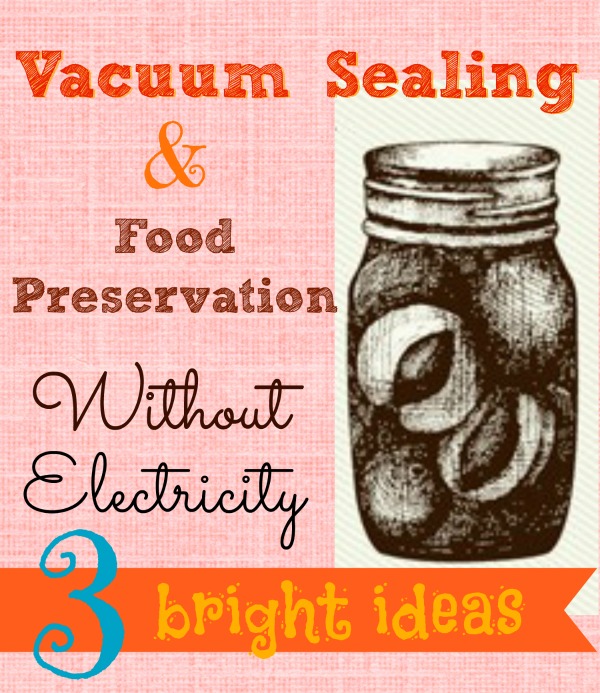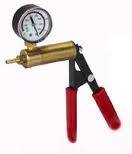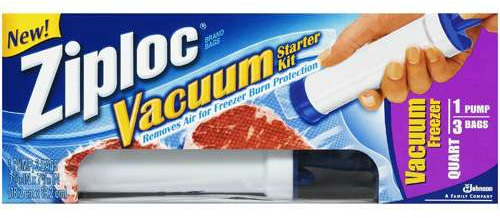I’ve recently come across a couple of good ideas that can be “thought forward” to emergency preps. They share a similar theme, so I decided it was worth a post to combine them. Today’s idea is preserving fresh items (or pantry items opened prematurely) in the event you’re without electricity. Some might think this is a funny thing to prepare for, but if the lights go “out” my belief is that they won’t be coming back “on” all too quickly, so we’d better be ready to adapt.
Fresh Foods in Food Storage?
In addition to all the shelf stable food items we store, preparing a plan to grow fresh foods by learning to garden and sprout (so long as conditions allow it) is extremely important to consider. Nutritionally as well as for so many other reasons, having a bit of fresh food to eat, even in small amounts, would be (and I use this adjective most sincerely) *awesome*. The problem is, we’d likely have times in growing food where there’s a surplus; we can’t use it up fast enough and don’t want it to go to waste. Well, there are a couple of ideas I’ve come across to help in this area that I’d like to share.
Idea #1: Brake Bleeder
Thanks goes out to Survivor Jane for this first idea. She shared it on facebook a couple weeks ago. Here’s a pop quiz: on your honor, how many of you already knew about this repurposed tool? Well, to me, this was a new one.
Apparently, this is a brake bleeder tool who’s original intended use is to bleed car brakes (as if I have any idea what that means). But…(and this is the cool part)…it uses a non-electric vaccuum sealing mechanism to do it’s job. According to Jane, it can also be used (thinking forward to preparedness) as a non-electric vacuum sealer by being attached to a foodsaver lid adaptor/ vacuum tube where it can seal food in mason jars. What a great repurposed item! She says it can be purchased directly from Harbor Freight (and like stores, I’d imagine), but additionally I found it here on Amazon (59% discounted) for $30.
Idea #2: Handheld Vacuum Pump Technique
A second non-electric vacuum sealing idea I found is surprisingly inexpensive. Using a $5 handheld vacuum pump, a thumbtack and a piece of electrical tape, you can seal a glass jar. And what’s great about this idea is that it works with *any* jar you have so long as you have a lid that screws on; it doesn’t necessarily need to be a canning jar. As I think about all the jars I have in my storage, it would be great to be able to re-purpose the smaller sized jars to preserve smaller food amounts if needed. This video demonstrates what I’m talking about. Think it forward to how valuable knowing this (and having this tool on hand) could be if/when fresh foods are hard to come by and you don’t want yours to go to waste!
The original article can be read here. (Oh, and btw, if you’re reading by email you’ll need to visit this post on the blog itself to be able to see the video.)
Idea #3: Zeer Pot (aka Pot in Pot Refrigeration)
So, now you’re wondering “what about refrigeration”? Fresh foods (most anyway) need to be kept cool, right? Ideally, yes. My line of thinking here is simply to have a way to keep foods good longer than they usually could be kept without doing anything.
So, my answer to refrigeration without electricity are Zeer pots. Again, here’s a video explanation. This project is on my list of things to study out this year to see how far it can be utilized, which size is best (if there’s a difference in temperature retention), etc. And as a side note, for anyone who needs to keep refrigerated medications, you (especially) need to check this out! Zeer pots have been tested and used for years in underdeveloped countries, so I trust this idea enough to post about it.
***
Well, I hope I’ve given you some good ideas to consider. It’s great to know you do have options in preserving food without electricity.





I loved the post as well as the videos, this methods of vacuum sealing does not need electricity so that is a real help to lessen power consumption, thanks so much for sharing such easy methods!
Thanks!
thanks for sharing experience !
You mentioned you got your wonder box beads locally. Where are you located and what was your source. I’m in SE idaho and having no luck finding beads and I have a group that wants to make 40 of them. All women who have never had one before or used one before. I would love to be able to drop the cost if I didn’t have to pay shipping on the beads. Thanks.
To find a local supplier of the styrene beads, I called a national supplier of foam products, Insulfoam (1-800-228-4412), and asked where in my area they supplied “unexpanded polystyrene bead”. From there I was given a local supplier, which (in my area) referred to them as “virgin beads”. Hopefully that will help. Please let me know if this doesn’t get you anywhere and I can reach out to my supplier to see if they might be able to give me any leads that might help. That’s so exciting that you’ve gotten a big group ready to make wonder ovens!! 🙂
Thanks for the info. I will give that a try on Monday.
The vacuum sealing machine seems as a great idea! The post is really useful! Thanks for the ideas! Greets, Storage Lower Morden Ltd
Glad to see a post from you, you’re one of my favorite blogs to visit, and you were my motivation to sew myself a wonder oven and gave me the kick in the pants I needed to get my 3 month food storage going!
*Flattered* thanks for that. 🙂
FYI… The brake bleeder can also be used as a ‘suction’ device in your first-aid / surgical kit. Of course, it would have to be a dedicated medical / Dental kit item and not a multiuse item. (I purchased a brand new high quality model on Amazon w/ multiple hose lines for under $40 and have it packed in a long term first-aid supply box.)
Thanks so much for adding this idea! It’s a great one! I went ahead and shared your comment on my facebook page.
I use my brake bleeder a lot.
When my vac sealer fails, the bb always works.
I built a Zeer pot last summer here in (then) steamy SE Ohio. The pot works best when it is hot AND dry, so the pot kept internal temperatures only about 10 to 15F cooler than outside. So, it’s better than no fridge at all, but probably not better than a root cellar, or a pit you could dig under a low deck.
Thanks for adding your experience. I’d love to hear what your lowest temp achieved was. I might email you to ask you more questions. Thanks!
I knew about the brake bleeder. This was good reminder to get it! Wow, you did not need to receive that brow-beating for one mistake.
Thanks 🙂
I have a Food Saver and love it. I will get a new canister set to use with it, or using the method you have described, use my attachments to seal the commercial jars that I use all the time anyway, but haven’t been able to re-seal. (Just an FYI: Those handy things that stop your car are brakes, not breaks. To break is to separate or cause to separate into pieces as a result of a blow, shock, or strain. The two words are homonyms.) You can break a break a glass; you brake your car, or your bicycle. Brakes don’t work well if they have air in the system, so that must be bled out, hence the name, “brake bleeder”. That device would be handy, but it is on the expensive side. There are other ways.
I remove air from the plastic bags I store my homemade bread in by holding the opening closed around a common drinking straw and sucking the air out before placing it in the freezer. The Food Saver isn’t gentle enough to do that without crushing the bread.
You can also use a simple old-fashioned bicycle pump, available for under $10. (Look in the bike section of Wal-Mart) It will either pump air in, as for a tire, or suck air out of something. Push down on the handle, it injects air. Pull the handle up, and it pulls air out. Ziplock brand also has a manual pump available in the bag section of the grocery store. It works just like a syringe to pull air out of a container.
Thanks for the “brake” correction, I’m glad you caught it for me. I was posting very late at night and made a silly spelling error. Your other suggestions are helpful. The bike pump (especially) is a smart idea.